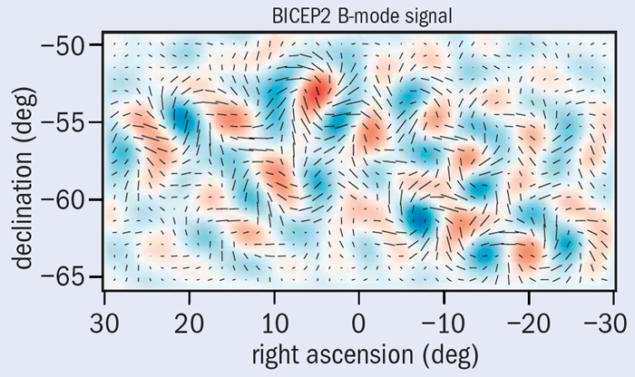
Image credit: BICEP2 collaboration.
The news came as a surprise on 17 March, making a “big bang” in the physics community. Within hours of the announcement, physicists around the world had become aware of the existence of the Background Imaging of Cosmic Extragalactic Polarization (BICEP2) telescope at the South Pole, and were hypnotized by the figure showing the swirling B-mode polarization of the cosmic microwave background (CMB), and by the profound implications of the discovery. The observations not only provide the first direct evidence for inflation, but also determine its energy scale and bear witness to a quantum-gravitational process.
The idea of cosmic inflation was originally proposed in 1980 by Alan Guth, then at Cornell University, to solve several cosmological problems identified in the 1970s. In this scenario, the inflationary epoch is an extremely brief period just after the Big Bang lasting a mere 10–32 s. During this minuscule fraction of a second, the universe would have expanded at superluminal speed by a factor of at least 1025. Inflation would result from a hypothetical inflaton field acting as a cosmological constant to produce an accelerated expansion of the universe. The inflation ends with the decay of the inflatons into Standard Model particles.
During inflation, quantum fluctuations of the inflaton field would be stretched and amplified to produce the density fluctuations of the CMB observed by the Wilkinson Microwave Anisotropy Probe and Planck satellites (CERN Courier May 2006 p12, May 2008 p8, May 2013 p12). Theorists have speculated further that quantum fluctuations of the space–time metric would also be “frozen in” by inflation, producing characteristic gravitational waves. From inflation to the recombination epoch – when electrons combine with protons to form hydrogen atoms – there would have been 380,000 years during which photons would scatter off electrons and become polarized. The net polarization of the CMB therefore reflects inhomogeneities in the hot plasma of the early universe.
Whereas both density and metric fluctuations can produce a gradient field in the sky – the so-called E-mode polarization – only metric fluctuations can produce the curl component of the polarization, the so-called B mode. Although there are foreground contaminations that can produce B modes at lower angular scales, finding B-mode polarization on the scale of a few degrees implies the presence of primordial gravitational waves.
It is this type of polarization that BICEP2 has discovered in the CMB. The signal is more than 100 times weaker than the intensity fluctuations of the CMB, which explains why these tiny variations at the 0.1 μK level have not been detected earlier. To achieve this precision, the BICEP2 experiment is equipped with 512 detectors cooled down to 0.27 K and installed at the South Pole. At an altitude of more than 3000 m, the site provides the closest conditions to space with cold, dry, stable air.
The strong B-mode signal found by the BICEP2 experiment corresponds to a tensor-to-scalar ratio r = 0.20 + 0.07 –0.05, with r = 0 disfavoured at the 6σ level. This is very good news for theorists who feared a much lower value of r, which would prevent the detection of B modes. The high-value of r implies an energy scale for inflation of around 2 × 1016 GeV. The BICEP2 measurements therefore offer a glimpse at physics at an energy approaching the Planck scale, where all of the fundamental forces are thought to be unified. This explains the burst of nearly 100 new publications citing the BICEP2 paper that had appeared by the end of March. The Planck satellite and other facilities now have the challenge of confirming these exciting results.
BICEP2 is the second stage of a co-ordinated programme with the BICEP and Keck Array experiments. The four principal investigators are John Kovac (Harvard/CfA), Clem Pryke (University of Minnesota), Jamie Bock (Caltech/JPL), and Chao-Lin Kuo (Stanford/SLAC).





